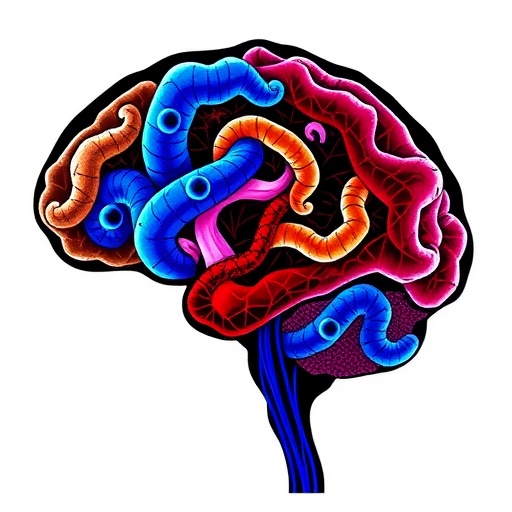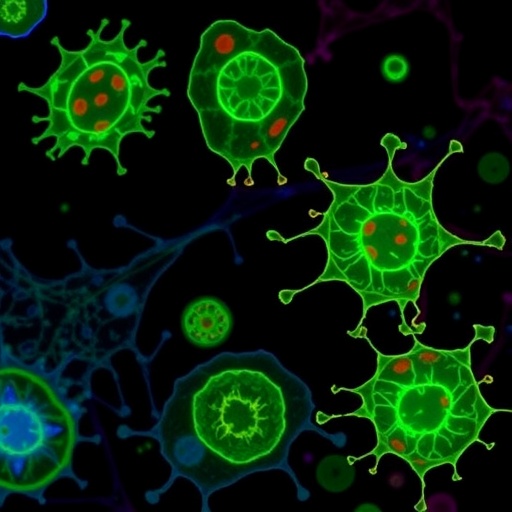Glioblastoma (GBM), a formidable adversary in neuro-oncology, stands as the most aggressive and common primary brain tumor, originating from glial cells. Despite the arsenal of surgery, radiation, and chemotherapy, patient prognosis remains disheartening, with a five-year survival rate lingering around 25%. A critical factor underpinning this daunting resilience lies in GBM’s cellular adaptability, driven by intricate molecular mechanisms that facilitate evasion from therapeutic assaults and foster relentless recurrence.
At the heart of this adaptability is a biological phenomenon known as epithelial‒mesenchymal transition (EMT), a process historically conceptualized in epithelial cancers but increasingly recognized for its pivotal role in glioma biology. EMT enables cancer cells to shift from an epithelial-like state, characterized by cell adhesion and polarity, to a mesenchymal phenotype marked by enhanced migratory capacity, invasiveness, and resistance to apoptosis. This transition endows GBM cells with plasticity, fostering survival under therapeutic stress and contributing to treatment resistance and tumor progression.
A recently published comprehensive review from collaborative efforts between Jinzhou Medical University, Technische Universität Dresden, and Helmholtz-Zentrum Dresden-Rossendorf sheds new light on the multifaceted role of EMT in GBM. Published in the journal Genes & Diseases, the review dissects the molecular undercurrents orchestrating EMT in glioblastoma, delineates its influences on tumor behavior, and analyses the therapeutic challenges and opportunities presented by targeting EMT-driven plasticity.
Central to the induction and maintenance of EMT in GBM is a complex signaling network integrating external cues and intracellular mediators. The review highlights critical pathways, including transforming growth factor-beta (TGF-β), phosphoinositide 3-kinase/Akt (PI3K/Akt), the Wnt/β-catenin cascade, Notch signaling, and hypoxia-inducible factors (HIFs). Activation of these intertwined molecular circuits promotes hallmark mesenchymal traits, enhancing migratory and invasive properties of GBM cells along with sustaining glioblastoma stem cells (GSCs) — a subpopulation notorious for its intrinsic resistance to chemotherapy and radiotherapy.
The intricate cross-talk among these pathways forms an adaptive web that not only drives phenotypic plasticity but also cloaks the tumor in resistance shields. For instance, TGF-β signaling triggers transcription factors that repress epithelial markers while inducing mesenchymal genes, facilitating extracellular matrix remodeling and invasion. Simultaneously, Wnt/β-catenin signaling amplifies stemness and proliferation, whereas hypoxic microenvironments stabilize HIFs, further enhancing EMT activation and metabolic reprogramming crucial for tumor survival.
Molecular signatures of EMT in GBM, such as overexpression of N-cadherin, vimentin, and transcription factors like TWIST, SNAIL, and ZEB, serve not only as indicators of disease progression but also as prognostic biomarkers. Elevated levels of these proteins correlate with more aggressive tumor phenotypes and poorer clinical outcomes, marking them as potential stratification tools for identifying high-risk patient subsets and tailoring treatment protocols accordingly.
Targeting EMT in GBM emerges as an enticing therapeutic avenue, yet it is beset by formidable challenges. The blood–brain barrier (BBB), a selective physical and biochemical barricade, hampers efficient delivery of many pharmacological agents to the tumor site. Additionally, GBM’s phenotypic plasticity enables compensatory activation of alternate signaling pathways when one is inhibited, diminishing monotherapy efficacy and fostering treatment escape.
Nevertheless, innovative therapeutic strategies aiming to disrupt EMT-associated mechanisms showcase promising preclinical results. Naturally derived compounds such as resveratrol, luteolin, and melatonin have demonstrated capability to modulate EMT signaling pathways, attenuating migratory and invasive behaviors. Parallelly, monoclonal antibodies like YYB-101 and small-molecule inhibitors—including metformin, foretinib, and STAT3 inhibitors—have entered the spotlight for their potential to sensitize GBM cells to conventional treatments and impair tumor dissemination.
Future therapeutic paradigms are envisioned to employ combination regimens that concurrently target multiple EMT-associated pathways, circumventing compensatory network activation. The review underscores the importance of devising agents that can effectively penetrate the BBB, advocating for advanced delivery platforms such as nanotechnology-based carriers to optimize drug bioavailability in the brain microenvironment.
A critical element emphasized is the necessity of biomarker-driven patient selection strategies. By stratifying patients based on EMT-related molecular profiles, clinicians may personalize treatment modalities, maximizing therapeutic benefit while minimizing toxicity. This precision medicine approach could revolutionize the management of GBM, shifting away from the current one-size-fits-all paradigm toward more nuanced, tailored interventions.
An exciting frontier highlighted by the review involves the integration of EMT-targeting agents with existing therapies. Synergistic combinations that pair EMT inhibitors with radiation or chemotherapy aim not only to suppress tumor growth but also to prevent the emergence of resistant cell populations that underlie recurrence and progression. This multidimensional assault on GBM’s vulnerabilities represents a significant leap forward in therapeutic design.
Understanding the intersection between EMT, glioblastoma stemness, and tumor microenvironment intricacies paves the way for the development of next-generation therapeutics poised to tackle the disease’s lethal plasticity. The review calls for intensified research efforts focused on molecular characterization, biological modeling, and clinical validation to transform promising preclinical findings into effective clinical interventions.
In conclusion, the formidable challenge posed by glioblastoma’s adaptability through EMT underscores the urgent need for innovative approaches that disrupt this process. By unraveling the signaling pathways and molecular drivers sustaining EMT, the scientific community moves closer to overcoming therapeutic resistance. The insights provided by this comprehensive review form a cornerstone for future advancements, galvanizing endeavors to extend survival and improve quality of life for patients battling this devastating brain cancer.
Subject of Research: Epithelial‒mesenchymal transition (EMT) in glioblastoma initiation, progression, and treatment resistance.
Article Title: The significance of epithelial‒mesenchymal transition (EMT) in the initiation, plasticity, and treatment of glioblastoma
News Publication Date: Not specified
Web References:
https://www.sciencedirect.com/journal/genes-and-diseases
References:
DOI: 10.1016/j.gendis.2025.101711
Image Credits: Pu Xia
Tags: cellular adaptability in brain tumorsepithelial-mesenchymal transition in cancerglioblastoma and therapeutic evasionglioblastoma treatment resistanceglioma biology and EMTinterdisciplinary research in neuro-oncologymesenchymal phenotype in cancermolecular mechanisms of glioblastomaneuro-oncology advancementssurvival rates in glioblastoma patientstherapeutic strategies for glioblastomatumor progression in glioblastoma





